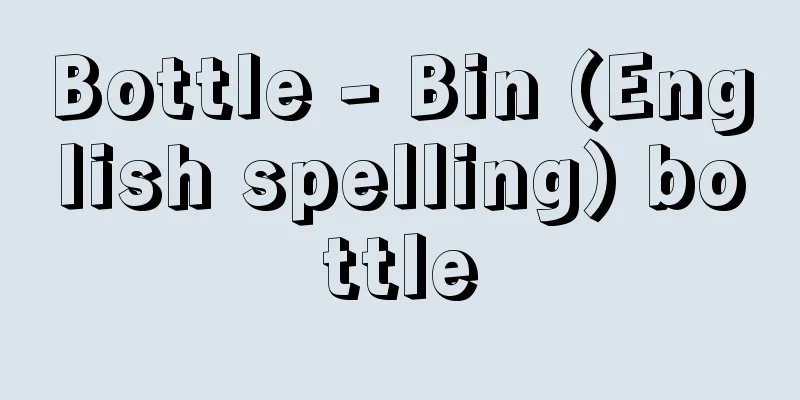Bottle - Bin (English spelling) bottle

|
A container made primarily to hold liquids. Chemically inert materials are used. Bottles are made of glass, plastic, ceramics, etc. Plastic bottles have a short history, but their use is growing rapidly, and in some cases they are being replaced by glass bottles. Ceramic bottles are mainly used as art and craft items. [Minami Tsutomu] Glass bottleIt is said that in the middle of the 1st century BC in Syria on the eastern coast of the Mediterranean Sea, a method of shaping glass by attaching molten glass to the end of a metal pipe and blowing air into the other end (hand-blowing method) was invented. The oldest surviving item in Japan is the white lapis lazuli bottle housed in the Shosoin Repository. It is thought to be an Iranian product from the 7th or 8th century. Bottle manufacturing in Japan is a relatively recent development, dating back to around 1844-1854 (the Koka and Kaei eras), with records showing that bottles were made in Edo by Machidaya Tobei and Kagaya Kyubei. Additionally, the Shimazu clan of Kagoshima began manufacturing medicine bottles at the glass factory of Shuseikan in 1852 (Kaei 5). Until 1904, when American entrepreneur and inventor M. J. Owens invented a fully automatic bottle-making machine, bottles were basically made by hand-blowing. Today, the mainstream method is the IS (Individual Section) machine, an improved version of the machine invented by Owens. A mixture of glass raw materials, such as silica sand, soda ash, and lime, is heated and melted at about 1500°C and made into a lump of appropriate size (called a gob). Air is blown into this from below to make it hollow (called a parison), and then it is turned upside down and air is blown in again to give it the desired shape. This method is called blow molding. Glass bottles have the following characteristics: the contents are easily visible, they do not react with the contents, they are chemically stable, and they can be made airtight. They are used to store various beverages and medicines. On the other hand, their disadvantages of being heavy and easily broken have been improved by making them thinner and lighter, and by strengthening them. For example, a 1-liter bottle weighed 640 grams in 1975, but by 1980 it was lightened to 320 grams, and they were put into practical use as one-time use bottles. Furthermore, returnable bottles that are used repeatedly have been lightened to the same extent by applying a resin coating to the outer surface. Glass bottles are excellent in terms of resource conservation, as they can be collected after use and reused as cullet (scrap glass), the raw material for glass. The production of glass bottles in Japan is decreasing year by year due to weight reduction and the spread of plastic bottles and paper containers, while the use of cullet is increasing. For example, 2.4 million tons of glass bottles were manufactured in 1990 (the largest annual shipment in Japan, amounting to 11 billion bottles), of which cullet accounted for 50%; however, in 1999, 1.9 million tons were manufactured, of which just under 80% was cullet. Also, to reduce weight and make recycling easier, colored glass bottles are now being manufactured by applying a resin coating several micrometers thick to transparent bottles. Furthermore, research and development is underway to create glass bottles that do not require separate collection by coating them with a colored gel film less than 1 micrometer in thickness, and this is expected to be put into practical use. [Minami Tsutomu] Plastic bottleThey are made from thermoplastic resin, which softens and hardens when heated and cooled, and can be made by blow molding, just like glass bottles. A variety of plastic materials have been used, including polyethylene, polyvinyl chloride, and polyethylene terephthalate (PET), but PET bottles are now mainstream. PET bottles are lightweight and highly safe, being unlikely to break even if dropped, and their market has expanded rapidly since the mid-1990s as containers for beverages and food products such as soy sauce. Initially, PET bottles had insufficient internal pressure resistance and impact resistance, and poor heat resistance, limiting their market. However, biaxial stretch blow technology and mouth crystallization technology have been developed, dramatically improving strength, gas barrier properties, and heat resistance, and now the target market is wide, including beverages that generate internal pressure, such as carbonated drinks, and beverages that require high-temperature filling, such as tea. Furthermore, aseptic filling technology has become common, it has become relatively easy to fill beverages at room temperature, even though they previously required high-temperature filling for hygiene reasons. PET bottles used with this room-temperature filling method do not require the heat-resistant technology mentioned above, and in addition, they can be made lighter, and they have been rapidly adopted in terms of resource conservation. Numerically, production volume was about 130,000 tons in 1993, and increased to about 280,000 tons (for food use) in 1998. Recycling has not kept up with the rapid expansion in use, but in 1998, about 17% of production volume was recovered and reused, mainly for fibers (48%), molded products (30%), sheets (15%), etc. [Minami Tsutomu] "Easy-to-recycle colored glass bottles" by Kanazawa Hidefumi (published in Nikkei Mechanical, no. 507, 1997, Nikkei BP) "The current state of and efforts in glass bottle recycling" by Mori Masahiro (published in Packaging Technology, vol. 37, no. 7, 1999, Japan Packaging Technology Association) "Re-commercialization of PET bottles" by Miwa Genshu (published in Packaging Technology, vol. 37, no. 8, 1999, Japan Packaging Technology Association) " Hiroyuki Nakasumi "Preparation and applications of organic-inorganic composite coating thin films" (published in Organic-Inorganic Hybrid Materials Technology Data Collection, 1999, Technology Information Association) [Reference items] | | | | | | | | |Source: Shogakukan Encyclopedia Nipponica About Encyclopedia Nipponica Information | Legend |
|
主として液体を保持するためにつくられた容器。化学的に不活性な材質が用いられる。瓶にはガラス製とプラスチック製、陶磁器製などがあり、プラスチック瓶はまだ歴史は浅いが、急激に利用が伸びており、用途によってはガラス瓶に置き換わりつつある。また、陶磁器製は美術工芸品としての用途がおもなものになっている。 [南 努] ガラス瓶紀元前1世紀中ごろ、地中海東岸のシリアで、金属パイプの先端に溶けたガラスをくっつけて、もう一方の端から息を吹き込んで成形する方法(手吹き法)が発明されたといわれている。 日本に現存する最古のものは、正倉院所蔵の白瑠璃瓶(はくるりのへい)である。これは7~8世紀ごろのイラン製品が渡来したものと考えられている。日本における瓶製造は比較的近年のことで、1844~1854年(弘化(こうか)・嘉永(かえい)年間)ごろからであり、江戸で町田屋藤兵衛、加賀屋久兵衛らがつくったという記録がある。また、鹿児島の島津氏は1852年(嘉永5)集成館のガラス工場で薬瓶を製造している。 1904年、アメリカの事業・発明家M・J・オーエンズが完全自動製瓶機を発明するまで、基本的には手吹き法で瓶がつくられてきた。現在ではオーエンズの発明した機械を改良したIS(Individual Section)機が主流になっている。ガラス原料である珪砂(けいさ)、ソーダ灰、石灰などの混合物を、約1500℃で加熱溶融して、適当な大きさの塊(ゴブという)にする。これに下方から空気を吹き込んで中空(パリソンという)にしたのち、上下を逆さにしてふたたび空気を吹き込み、希望の形状にする。このような方法を吹き込み成形法という。 ガラス瓶は、内容物が見やすい、内容物と反応せず化学的に安定である、気密にすることができるといった特徴があり、各種の飲料や薬品などの貯蔵に利用されている。一方、重くて割れやすいという欠点は、薄肉・軽量化して、しかも強化処理をすることにより改善が進められている。たとえば1リットルの瓶は1975年(昭和50)に640グラムであったのが、1980年には320グラムまで軽量化され、一度だけ使うワンウェイ瓶として実用化された。さらに、繰り返し使用されるリターナブル瓶に対しても、外表面に樹脂コーティングを施すことによって、同程度まで軽量化されている。ガラス瓶は使用後回収され、ガラス原料のカレット(屑(くず)ガラス)として再利用できるので、省資源の点で優れている。日本におけるガラス瓶の生産量は、軽量化や、プラスチック瓶や紙容器の普及などのために、年々減少しており、一方カレットの使用量は増大している。たとえばガラス瓶は1990年(平成2)に240万トン製造(日本における年間最大出荷量、本数にして110億本)され、そのうちカレット使用量は50%であったのが、1999年には190万トン製造され、その80%弱がカレットでまかなわれている。また軽量化も兼ねてリサイクルを容易にするために、透明瓶に厚さ数マイクロメートルの樹脂コーティングを施して、着色ガラス瓶が製造されるようになっている。さらに1マイクロメートル以下の着色ゲル膜をコーティングすることによって、分別回収の必要のないガラス瓶の開発研究が進んでおり、実用化が期待されている。 [南 努] プラスチック瓶加熱・冷却によって、軟らかくなったり、硬くなったりする熱可塑性樹脂を原料として、ガラス瓶と同じく、吹き込み成形でつくることができる。プラスチック材料としてポリエチレン、ポリ塩化ビニル、ポリエチレンテレフタレート(PET(ペット))などさまざまなものが使用されてきたが、現在ではペットボトルが主流になっている。ペットボトルは軽量であって、落としても破損しにくく安全性に優れた容器として、飲料、しょうゆなどの食品用として1990年代中ごろから急速に市場を拡大した。 当初、ペットボトルは耐内圧強度や耐衝撃強度が不十分であり、耐熱性に乏しく、その市場が限定されていた。しかし2軸延伸ブロー技術や口部結晶化技術などが開発されて強度やガスバリヤー性、そして耐熱性が飛躍的に向上し、現在では炭酸飲料のように内圧が発生するものや茶類のように高温充填(じゅうてん)を必要とする飲料など、対象となる市場は広範囲に及んでいる。さらに、無菌充填技術が一般化しており、以前は衛生上の問題で高温充填が必要であった飲料でも、常温での充填が比較的容易に行えるようになった。この常温充填方式で使用されるペットボトルは、前述した耐熱性技術が不要となり、加えて軽量化も図ることができ、省資源の観点からも評価されて急速に普及した。 数値的には1993年に約13万トンの生産量だったものが1998年には約28万トンまで伸びた(食品用)。リサイクルについては、急激な使用拡大に追いついていないのが現状であるが、1998年には生産量の約17%が回収され、おもに繊維(48%)、成形品(30%)、シート(15%)などに再使用されている。 [南 努] 『金澤秀文著「リサイクルしやすい着色ガラスびん」(『日経メカニカル』507号所収、1997・日経BP社)』▽『森雅博著「ガラスびんリサイクルの現状および取り組み」(『包装技術』37巻7号所収、1999・日本包装技術協会)』▽『三輪玄修著「PETボトルの再商品化」(『包装技術』37巻8号所収、1999・日本包装技術協会)』▽『中澄博行著「有機・無機複合コーティング薄膜の作製と応用」(『有機・無機ハイブリッド材料技術資料集』所収、1999・技術情報協会)』 [参照項目] | | | | | | | | |出典 小学館 日本大百科全書(ニッポニカ)日本大百科全書(ニッポニカ)について 情報 | 凡例 |
>>: Second - biyou (English spelling) second
Recommend
Muḥammad al-Ghazzali (English spelling)
…However, during this time, under Hasan Isma'...
Construction site
…In his many books, he established the theoretica...
Igor'
?-945 Grand Prince of Kiev. Reigned 912-945. De fa...
Bibān al-Mulūk (English spelling)
…the New Kingdom royal cemetery on the west bank ...
Draft system
A system by which teams acquire the right to negot...
Orthoptera - Orthoptera
A general term for the order Orthoptera of the cl...
American Bison (English spelling)
Order: Even-toed ungulate; family: Bovidae. In Ame...
barocco
...Generally, it refers to an anti-classical art ...
Codominance - Codominance
… Because there is no dominance or inferiority be...
Tentsuki - Amatsuke
...Population: 20,097 (1995). The Jomon and Yayoi...
Usuki-Yatsushiro Tectonic Line
...The prefecture's name was later changed to...
Stockholm International Peace Research Institute - Stockholm International Peace Research Institute
Stockholm International Peace Research Institute (...
Chain pipe wrench - Chain pipe wrench
…When turning, turn the pipe in the direction tha...
Number - Number
[1] [noun] ① A name indicating the order of things...
GI Bill of Rights
...In Japan, GIs were popular in the streets from...


![Katsunuma [town] - Katsunuma](/upload/images/67cb3850c0335.webp)


![China [town] - China](/upload/images/67cc2eec422a0.webp)



